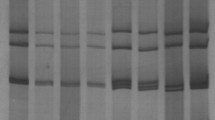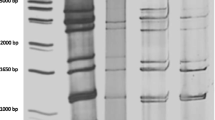Abstract
Rotavirus is the most common cause of severe diarrhea in children worldwide. Monitoring the diversity of rotavirus strains is of great importance for current and future vaccination programs. To determine the diversity of rotavirus circulating in Asuncion, Paraguay, between 2006 and 2007, we carried out a molecular characterization of rotaviruses detected in children <5 years old and adults (>18 years old). We found that the most common circulating strain was G2P[4] (69/143), followed by G9P[8] (37/143). The temporal distribution of strains showed that, in children, G2P[4] was predominant in 2006, and that G2P[4] and G9P[8] were co-predominant in 2007, whereas in adults, G2P[4] was predominant in both years. Additionally, one G9P[6] and three G12P[9] strains were found in adult samples, making this the first report of these strains circulating in Paraguay. Sequence analysis of the G12P[9] strains suggests across-border migration of this strain within the southern cone of America.





Similar content being viewed by others
References
Amarilla A, Espinola EE, Galeano ME, Farina N, Russomando G, Parra GI (2007) Rotavirus infection in the Paraguayan population from 2004 to 2005: high incidence of rotavirus strains with short electropherotype in children and adults. Med Sci Monit 13:CR333–CR337
Araujo IT, Ferreira MS, Fialho AM, Assis RM, Cruz CM, Rocha M, Leite JP (2001) Rotavirus genotypes P[4]G9, P[6]G9, and P[8]G9 in hospitalized children with acute gastroenteritis in Rio de Janeiro, Brazil. J Clin Microbiol 39:1999–2001
Bok K, Castagnaro N, Borsa A, Nates S, Espul C, Fay O, Fabri A, Grinstein S, Miceli I, Matson DO, Gomez JA (2001) Surveillance for rotavirus in Argentina. J Med Virol 65:190–198
Boom R, Sol CJ, Salimans MM, Jansen CL, Wertheim-van Dillen PM, van der Noordaa J (1990) Rapid and simple method for purification of nucleic acids. J Clin Microbiol 28:495–503
Candia N, Parra GI, Chirico M, Velazquez G, Farina N, Laspina F, Shin J, De Sierra MJ, Russomando G, Arbiza J (2003) Acute diarrhea in Paraguayan children population: detection of rotavirus electropherotypes. Acta Virol 47:137–140
Castello AA, Nakagomi T, Nakagomi O, Jiang B, Kang JO, Glass RI, Glikmann G, Gentsch JR (2009) Characterization of genotype P[9]G12 rotavirus strains from Argentina: high similarity with Japanese and Korean G12 strains. J Med Virol 81:371–381
Das BK, Gentsch JR, Cicirello HG, Woods PA, Gupta A, Ramachandran M, Kumar R, Bhan MK, Glass RI (1994) Characterization of rotavirus strains from newborns in New Delhi, India. J Clin Microbiol 32:1820–1822
de Oliveira LH, Danovaro-Holliday MC, Matus CR, Andrus JK (2008) Rotavirus vaccine introduction in the Americas: progress and lessons learned. Expert Rev Vaccines 7:345–353
Espinola EE, Amarilla A, Arbiza J, Parra GI (2008) Sequence and phylogenetic analysis of the VP4 gene of human rotaviruses isolated in Paraguay. Arch Virol 153:1067–1073
Gentsch JR, Glass RI, Woods P, Gouvea V, Gorziglia M, Flores J, Das BK, Bhan MK (1992) Identification of group A rotavirus gene 4 types by polymerase chain reaction. J Clin Microbiol 30:1365–1373
Gouvea V, Glass RI, Woods P, Taniguchi K, Clark HF, Forrester B, Fang ZY (1990) Polymerase chain reaction amplification and typing of rotavirus nucleic acid from stool specimens. J Clin Microbiol 28:276–282
Grimwood K, Kirkwood CD (2008) Human rotavirus vaccines: too early for the strain to tell. Lancet 371:1144–1145
Gurgel RQ, Cuevas LE, Vieira SC, Barros VC, Fontes PB, Salustino EF, Nakagomi O, Nakagomi T, Dove W, Cunliffe N, Hart CA (2007) Predominance of rotavirus P[4]G2 in a vaccinated population, Brazil. Emerg Infect Dis 13:1571–1573
Heiman EM, McDonald SM, Barro M, Taraporewala ZF, Bar-Magen T, Patton JT (2008) Group A human rotavirus genomics: evidence that gene constellations are influenced by viral protein interactions. J Virol 82:11106–11116
Leite JP, Carvalho-Costa FA, Linhares AC (2008) Group A rotavirus genotypes and the ongoing Brazilian experience: a review. Mem Inst Oswaldo Cruz 103:745–753
Matthijnssens J, Ciarlet M, Heiman E, Arijs I, Delbeke T, McDonald SM, Palombo EA, Iturriza-Gomara M, Maes P, Patton JT, Rahman M, Van Ranst M (2008) Full genome-based classification of rotaviruses reveals a common origin between human Wa-like and porcine rotavirus strains and human DS-1-like and bovine rotavirus strains. J Virol 82:3204–3219
O’Ryan M, Matson DO (2006) New rotavirus vaccines: renewed optimism. J Pediatr 149:448–451
Page NA, Steele AD (2004) Antigenic and genetic characterization of serotype G2 human rotavirus strains from South Africa from 1984 to 1998. J Med Virol 72:320–327
Parashar UD, Hummelman EG, Bresee JS, Miller MA, Glass RI (2003) Global illness and deaths caused by rotavirus disease in children. Emerg Infect Dis 9:565–572
Parashar UD, Gibson CJ, Bresee JS, Glass RI (2006) Rotavirus and severe childhood diarrhea. Emerg Infect Dis 12:304–306
Parra GI, Bok K, Martinez V, Russomando G, Gomez J (2005) Molecular characterization and genetic variation of the VP7 gene of human rotaviruses isolated in Paraguay. J Med Virol 77:579–586
Parra GI, Espinola EE, Amarilla AA, Stupka J, Martinez M, Zunini M, Galeano ME, Gomes K, Russomando G, Arbiza J (2007) Diversity of group A rotavirus strains circulating in Paraguay from 2002 to 2005: detection of an atypical G1 in South America. J Clin Virol 40:135–141
Parra GI (2009) Seasonal shifts of group A rotavirus strains as a possible mechanism of persistence in the human population. J Med Virol 81:568–571
Patel MM, de Oliveira LH, Bispo AM, Gentsch J, Parashar UD (2008) Rotavirus P[4]G2 in a vaccinated population, Brazil. Emerg Infect Dis 14:863–865
Pietruchinski E, Benati F, Lauretti F, Kisielius J, Ueda M, Volotao EM, Soares CC, Hoshino Y, Linhares RE, Nozawa C, Santos N (2006) Rotavirus diarrhea in children and adults in a southern city of Brazil in 2003: distribution of G/P types and finding of a rare G12 strain. J Med Virol 78:1241–1249
Pongsuwanna Y, Guntapong R, Chiwakul M, Tacharoenmuang R, Onvimala N, Wakuda M, Kobayashi N, Taniguchi K (2002) Detection of a human rotavirus with G12 and P[9] specificity in Thailand. J Clin Microbiol 40:1390–1394
Rahman M, Matthijnssens J, Yang X, Delbeke T, Arijs I, Taniguchi K, Iturriza-Gomara M, Iftekharuddin N, Azim T, Van Ranst M (2007) Evolutionary history and global spread of the emerging G12 human rotaviruses. J Virol 81:2382–2390
Samajdar S, Varghese V, Barman P, Ghosh S, Mitra U, Dutta P, Bhattacharya SK, Narasimham MV, Panda P, Krishnan T, Kobayashi N, Naik TN (2006) Changing pattern of human group A rotaviruses: emergence of G12 as an important pathogen among children in eastern India. J Clin Virol 36:183–188
Santos N, Volotao EM, Soares CC, Albuquerque MC, da Silva FM, de Carvalho TR, Pereira CF, Chizhikov V, Hoshino Y (2001) Rotavirus strains bearing genotype G9 or P[9] recovered from Brazilian children with diarrhea from 1997 to 1999. J Clin Microbiol 39:1157–1160
Santos N, Hoshino Y (2005) Global distribution of rotavirus serotypes/genotypes and its implication for the development and implementation of an effective rotavirus vaccine. Rev Med Virol 15:29–56
Schumann T, Hotzel H, Otto P, Johne R (2009) Evidence of interspecies transmission and reassortment among avian group A rotaviruses. Virology 386:334–343
Shinozaki K, Okada M, Nagashima S, Kaiho I, Taniguchi K (2004) Characterization of human rotavirus strains with G12 and P[9] detected in Japan. J Med Virol 73:612–616
Stupka JA, Parra GI, Gomez J, Arbiza J (2007) Detection of human rotavirus G9P[8] strains circulating in Argentina: phylogenetic analysis of VP7 and NSP4 genes. J Med Virol 79:838–842
Stupka JA, Carvalho P, Amarilla AA, Massana M, Parra GI (2009) National Rotavirus Surveillance in Argentina: High incidence of G9P[8] strains and detection of G4P[6] strains with porcine characteristics. Infect Genet Evol 9:1225–1231
Swofford DL (2003) PAUP*. Phylogenetic analysis using parsimony (*and other methods). Version 4. Sinauer Associates, Sunderland
Tamura K, Dudley J, Nei M, Kumar S (2007) MEGA4: Molecular Evolutionary Genetics Analysis (MEGA) software version 4.0. Mol Biol Evol 24:1596–1599
Ursu K, Kisfali P, Rigó D, Ivanics E, Erdélyi K, Dán A, Melegh B, Martella V, Bányai K (2009) Molecular analysis of the VP7 gene of pheasant rotaviruses identifies a new genotype, designated G23. Arch Virol 154:1365–1369
Wakuda M, Nagashima S, Kobayashi N, Pongsuwanna Y, Taniguchi K (2003) Serologic and genomic characterization of a G12 human rotavirus in Thailand. J Clin Microbiol 41:5764–5769
Watanabe M, Nakagomi T, Koshimura Y, Nakagomi O (2001) Direct evidence for genome segment reassortment between concurrently-circulating human rotavirus strains. Arch Virol 146:557–570
Acknowledgments
We thank Maria Victoria Gonzalez Eusevi for her critical reading and editing of the manuscript.
Conflict of interest statement
The authors have no conflicts of interest to declare.
Author information
Authors and Affiliations
Corresponding author
Additional information
M. Martínez and G. I. Parra contributed equally to this work.
Electronic supplementary material
Below is the link to the electronic supplementary material.
Rights and permissions
About this article
Cite this article
Martínez, M., Amarilla, A.A., Galeano, M.E. et al. Predominance of rotavirus G2P[4] and emergence of G12P[9] strains in Asunción, Paraguay, 2006–2007. Arch Virol 155, 525–533 (2010). https://doi.org/10.1007/s00705-010-0617-0
Received:
Accepted:
Published:
Issue Date:
DOI: https://doi.org/10.1007/s00705-010-0617-0




